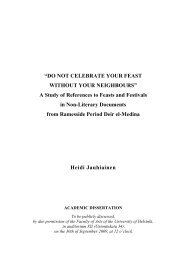BIA
bia51
bia51
Create successful ePaper yourself
Turn your PDF publications into a flip-book with our unique Google optimized e-Paper software.
JANVIER 2015<br />
stones. The emblems — on the forehead, a<br />
vulture and a cobra, and on the shoulders,<br />
falcon heads — depict the symbols of the Two<br />
Lands of Upper and Lower Egypt and of divine<br />
authority. The vulture Nekhbet and the cobra<br />
Wadjet were thought to protect the pharaoh.<br />
(Nevine El-Aref, “‘Cover-up’ claims denied”, Al-<br />
Ahram Weekly, January 29, 2015. Voir<br />
également Husâm al-Mahmûd, « Le masque de<br />
Toutankhamon abîmé au Musée Égyptien », al-<br />
‘Arabî al-Gadîd, 18 janvier ; AP, “Beard of<br />
Egypt’s King Tut hastily glued back on with<br />
epoxy”, Ahram Online, January 21 ; Nevine El-<br />
Aref, “Archaeological committee to inspect<br />
'glued' Tutankhamun’s gold mask and beard”,<br />
Ahram Online, January 22 ; Fâtima Zaydân,<br />
« La restauration erronée défigure le masque<br />
de Toutankhamon », al-Masrî al-Yawm, 23<br />
janvier ; Dîna ‘Abd al-‘Alîm, « Les restaurateurs<br />
de Toutankhamon déférés devant le Parquet »,<br />
al-Yawm al-Sâbi‘, 24 janvier ; Ahmad Mansûr,<br />
« Le ministère de l’Archéologie organise une<br />
conférence de presse sur la crise de<br />
Toutankhamon », al-Yawm al-Sâbi‘, 24 janvier ;<br />
« Le ministre de l’Archéologie reconnaît la<br />
détérioration du masque de Toutankhamon »,<br />
al-‘Arabî al-Gadîd, 24 janvier ; Muna Yâsîn,<br />
« Crime au Musée Égyptien », al-Masrî al-<br />
Yawm, 25 janvier ; Nevine, El-Aref, “International<br />
museum body demands answers over<br />
Tutankhamen damage”, Ahram Online, January<br />
25 ; Alâ’ ‘Uthmân, « Les restaurateurs du<br />
ministère de l’Archéologie : le produit utilisé<br />
pour coller la barbe de Toutankhamon est<br />
légal », al-Yawm al-Sâbi‘, 25 janvier ; Reuters,<br />
« L’ICOM est disposé à participer à la<br />
restauration du masque de Toutankhamon »,<br />
al-Shurûq, 25 janvier ; Muhammad ‘Abd al-Mu‘tî,<br />
« Intervention internationale urgente pour<br />
sauver le masque de Toutankhamon », al-<br />
Ahrâm, 26 janvier ; Ahmad Mansûr, « al-Damâtî<br />
limoge la directrice du service de restauration<br />
du Musée Égyptien après le scandale de<br />
Toutankhamon », al-Yawm al-Sâbi‘, 26 janvier ;<br />
Nasma Réda, « Masque de Toutankhamon : La<br />
polémique bat son plein », Al-Ahram Hebdo du<br />
28 janvier ; Muhammad ‘Abd al-Mu‘tî, « IRM et<br />
cellule de crise autour du masque de<br />
Toutankhamon », al-Ahrâm, 29 janvier ; Muna<br />
Yâsîn, « L’expert chargé d’examiner le masque<br />
de Toutankhamon : la restauration a été<br />
réalisée par des sagouins ! », al-Masrî al-Yawm,<br />
29 janvier).<br />
- -<br />
In 1905-1906, US archaeologist Edward<br />
AYRTON, who was sponsored by the American<br />
millionaire Theodore DAVIS, found six tombs in<br />
the Valley of the Kings, KV48 to 53. The first<br />
five tombs contained animal bones, and it was<br />
therefore believed that these tombs were built<br />
for the pharaoh Amenhotep II’s pets.<br />
Over time, sand covered some of the<br />
tombs, including KV53, and they were lost.<br />
However, an Egyptian expedition led by the<br />
present writer was later able to relocate KV53<br />
during a search for lost tombs in the Valley of<br />
the Kings.<br />
The square shaft of the tomb leads to a<br />
relatively small rectangular chamber. In his<br />
original account, AYRTON wrote that the tomb<br />
had been robbed. The only object of note<br />
found was a piece of stone bearing the name<br />
of a man called Huri, who was the “overseer of<br />
scribes in the palace of justice,” meaning the<br />
royal Theban necropolis.<br />
This might have indicated that Huri was the<br />
tomb’s owner. Archaeologist Nicholas REEVES<br />
writes that a stela for the goddess Meretseger<br />
was also found in KV53. Our team found other<br />
objects in the tomb, including pottery shards,<br />
fragments of linen and pieces of wood that<br />
might have been part of a coffin.<br />
The Egyptian expedition also found four<br />
wonderful canopic jar lids. The lids were in the<br />
form of human heads with eyebrows and eyes<br />
in black paint and a hieroglyphic sign engraved<br />
on the top of each head in order to identify it.<br />
A v-shaped object made of gold was also<br />
found in the tomb, together with an amphora<br />
dating back to 1400-1300 BCE.<br />
However, the most important discovery in<br />
KV53 was the human remains: bones and three<br />
human skulls were found in the burial chamber.<br />
Study of the remains showed that three people<br />
were buried in KV53: a man aged 45 at the<br />
time of his death, a second man who died at<br />
the age of 20, and a woman who died at 23.<br />
We believe that the older man is the owner<br />
of the tomb, while the young man and woman<br />
could be his son and daughter. However, the<br />
identity of those buried in KV53 is still the<br />
subject of debate. The tomb is dated to the<br />
18 th Dynasty. (Zâhî Hawwâs, “The rediscovery of<br />
KV53”, Al-Ahram Weekly, January 29, 2015).<br />
<strong>BIA</strong> LI — Janvier/Juin 2015 30



